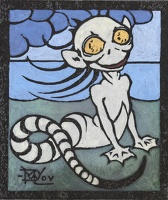Marion Wallace Dunlop
Marion Wallace Dunlop (1864–1942) was a prominent figure in the British suffragette movement, known for her pioneering tactics in the fight for women's suffrage. As an artist and political activist, Dunlop made significant contributions to the cause, most notably through her use of hunger strikes as a form of protest, a tactic that would become a hallmark of the suffragette movement.
Early Life[edit | edit source]
Marion Wallace Dunlop was born in 1864, into a family with a strong sense of justice and political activism. From a young age, she was exposed to discussions about women's rights and social reform, which shaped her later involvement in the suffragette movement. Dunlop pursued an education in art, attending the Royal College of Art in London, where she honed her skills as an illustrator and printmaker. Her artistic talents would later play a crucial role in her activism, as she designed posters, banners, and other materials for the suffragette cause.
Suffragette Movement[edit | edit source]
In the early 20th century, Dunlop became actively involved with the Women's Social and Political Union (WSPU), a militant organization fighting for women's suffrage in the United Kingdom. She was deeply committed to the cause and sought innovative ways to draw attention to the suffragettes' demands. In 1909, Dunlop made history by initiating the first hunger strike as a form of protest after being arrested for defacing a wall at the House of Commons with a quotation from the Bill of Rights stating that it was the right of the subjects to petition the king.
Her hunger strike caught the authorities off guard, and after 91 hours without food, she was released from prison. This act of defiance inspired other suffragettes to adopt the hunger strike as a key strategy in their fight for suffrage, leading to the British government's controversial use of force-feeding.
Art and Activism[edit | edit source]
Dunlop's contributions to the suffragette movement were not limited to her political activism. She also used her artistic talents to support the cause, creating powerful and iconic imagery that conveyed the suffragettes' messages and ideals. Her work was featured in various publications and exhibitions, helping to raise awareness and funds for the movement.
Later Life and Legacy[edit | edit source]
After women gained the right to vote in 1918, Dunlop continued to be involved in social and political causes, though her later years were more focused on her art than activism. She passed away in 1942, leaving behind a legacy of courage and creativity that continues to inspire those fighting for equality and justice.
Dunlop's pioneering use of the hunger strike as a form of protest and her contributions to the visual culture of the suffragette movement have cemented her place in history as a key figure in the fight for women's suffrage in the United Kingdom.
Search WikiMD
Ad.Tired of being Overweight? Try W8MD's physician weight loss program.
Semaglutide (Ozempic / Wegovy and Tirzepatide (Mounjaro / Zepbound) available.
Advertise on WikiMD
|
WikiMD's Wellness Encyclopedia |
| Let Food Be Thy Medicine Medicine Thy Food - Hippocrates |
Translate this page: - East Asian
中文,
日本,
한국어,
South Asian
हिन्दी,
தமிழ்,
తెలుగు,
Urdu,
ಕನ್ನಡ,
Southeast Asian
Indonesian,
Vietnamese,
Thai,
မြန်မာဘာသာ,
বাংলা
European
español,
Deutsch,
français,
Greek,
português do Brasil,
polski,
română,
русский,
Nederlands,
norsk,
svenska,
suomi,
Italian
Middle Eastern & African
عربى,
Turkish,
Persian,
Hebrew,
Afrikaans,
isiZulu,
Kiswahili,
Other
Bulgarian,
Hungarian,
Czech,
Swedish,
മലയാളം,
मराठी,
ਪੰਜਾਬੀ,
ગુજરાતી,
Portuguese,
Ukrainian
Medical Disclaimer: WikiMD is not a substitute for professional medical advice. The information on WikiMD is provided as an information resource only, may be incorrect, outdated or misleading, and is not to be used or relied on for any diagnostic or treatment purposes. Please consult your health care provider before making any healthcare decisions or for guidance about a specific medical condition. WikiMD expressly disclaims responsibility, and shall have no liability, for any damages, loss, injury, or liability whatsoever suffered as a result of your reliance on the information contained in this site. By visiting this site you agree to the foregoing terms and conditions, which may from time to time be changed or supplemented by WikiMD. If you do not agree to the foregoing terms and conditions, you should not enter or use this site. See full disclaimer.
Credits:Most images are courtesy of Wikimedia commons, and templates Wikipedia, licensed under CC BY SA or similar.
Contributors: Prab R. Tumpati, MD




